Infrastructure Business Area
Achieving Stable Operation of World’s Critical Infrastructure and Carbon Neutrality / Contributing to National Security in Japan and Asia
The Infrastructure Business Area (BA) comprises the public utility systems business, energy & industrial systems business, and defense & space systems business. Looking at the business environment for each, we recognize challenges such as the circular economy, carbon neutrality, labor shortages, measures for aging infrastructure, and the realization of a safe and secure society. The Infrastructure BA’s ideal vision is to contribute to solving these challenges by achieving stable operation of the world’s critical infrastructure and carbon neutrality while also contributing to national security in Japan and Asia.
Realizing a Society with Rich Water Cycle
Ozone Generator

Ozone Generator
Ozone is used in advanced water treatment processes and paper pulp bleaching due to its superior oxidizing power and ability to eliminate bacteria, odors, and colors. Mitsubishi Electric’s ozone generators have achieved higher efficiency and ozone concentrations with a more compact design by using thinner electrodes and greater electrode dimensional accuracy. As a result, overall system power consumption has been reduced by 15%. With lower power consumption, higher ozone concentration and more compact design, the applications of our ozone generators are expanding to various fields, including general industry, and they are helping to improve water environments both in Japan and overseas.
Related link
Helping to Create Safe, Secure and Comfortable Cities
Network camera systems
Network camera systems are not only capable of video recording and monitoring, but they are also expanding their applications with AI and image analysis technology to improving safety through early detection of suspicious objects, creating comfortable spaces by detecting congestion levels and traffic flows, and prevention and mitigation of disasters. We manufacture products such as the MELOOK series, which meets diverse requirements, as well as other products that are ideal for the surveillance of large, open areas such as public facilities, thereby fostering the development of safe and secure cities.
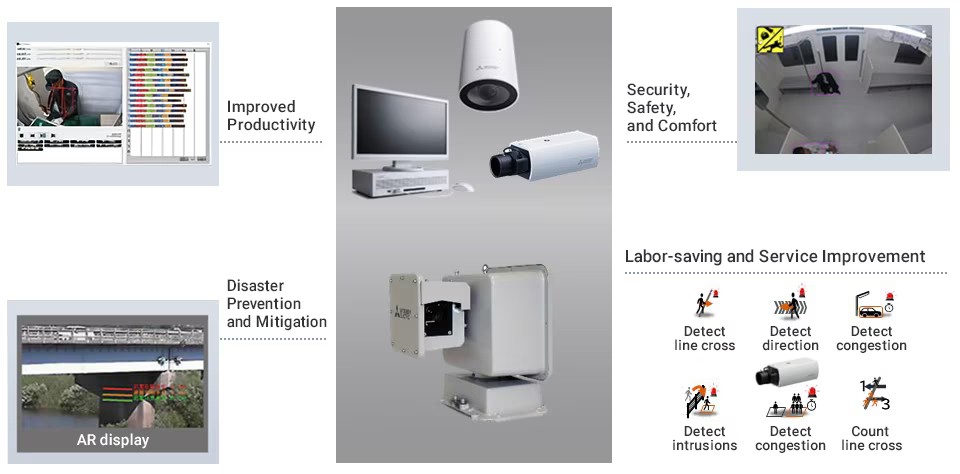 Network camera system
Network camera system
Related link
Contributing to a Decarbonized Society
Railway Data Analysis Service Utilizing Serendie Digital Platform
Mitsubishi Electric launched a railway data analysis service making use of its proprietary Serendie digital platform, which collects and analyzes data such as the power consumption of trains, substations and stations, as well as the operational status of trains. Based on the service, Mitsubishi Electric will provide ongoing support for railway operators in introducing equipment and energy-saving operation for trains, thereby helping to realize optimal energy usage by integrating collaboration in the use of railway assets with the energy-saving operation of trains.
Using these proposals, Mitsubishi Electric will help railway operators introduce the equipment they require to ensure optimal power consumption and the energy-saving operation of trains, contributing to the optimization of their energy usage through collaboration in the use of railway assets. Furthermore, by analyzing and utilizing the data collected during railway operation and facilitating the coordination of railway power systems with the availability of power systems in areas along railway lines, the company will help realize optimal energy supplies and thereby promote decarbonization.
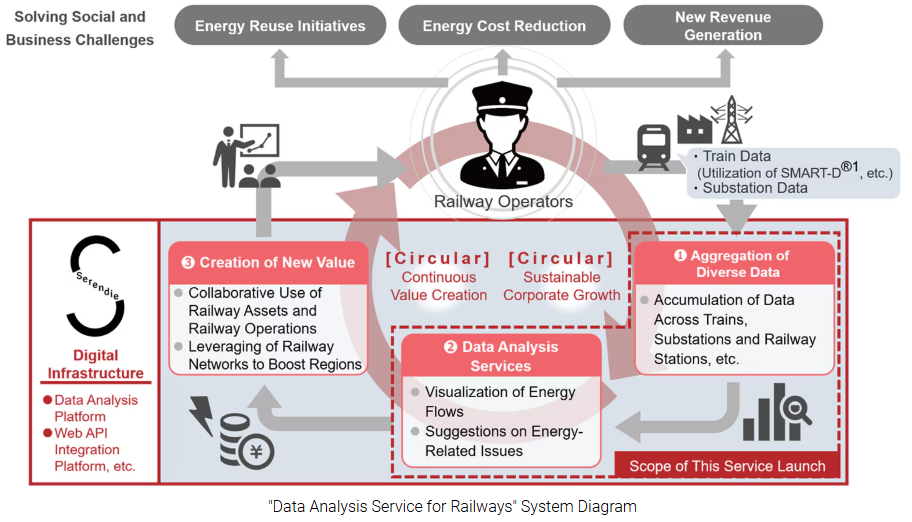 Railway Data Analysis Service Utilizing Serendie Digital Platform
Railway Data Analysis Service Utilizing Serendie Digital Platform
Related link
Environmentally Friendly Greenhouse Gas-Free Switchgears

Dry Air Insulated Switchgear
Mitsubishi Electric has expanded its product lineup of greenhouse gas-free switchgears installed in power converter stations. Switchgears often use SF6 gas, which has a greenhouse effect with a global warming potential of approximately 24,300 times that of CO2. However, Mitsubishi Electric has developed and delivered switchgears that do not use SF6 gas, responding to the need to reduce environmental impact and regulations on the use of SF6 gas in various countries. Going forward, by expanding our greenhouse gas-free product lineup and helping to stabilize the power grid, we will contribute to the realization of carbon neutrality and help build a society where everyone is able to use electricity with peace of mind.
Related link
Contributing to the Introduction of Clean Energy
Direct Current (DC) Transmission Technologies
Suitable locations for generation of renewable energy such as wind and solar power are usually some distance away from the locations where power is consumed. Losses occur during the power transmission process due to frequency and voltage conversion, as well as transmission losses. DC transmission and distribution technology is one way of reducing such losses and ensuring that power is used in a stable, efficient manner. Mitsubishi Electric is developing high voltage DC transmission (HVDC) systems, as well as DC circuit breakers, which are important for protecting the power grid. In addition, the D-SMiree system for medium- and low-voltage DC distribution provides a stable system for local production and consumption of power. Mitsubishi Electric will continue contributing to the spread of renewable energy and the realization of carbon neutrality with its DC technologies.
 D-SMiree
D-SMiree
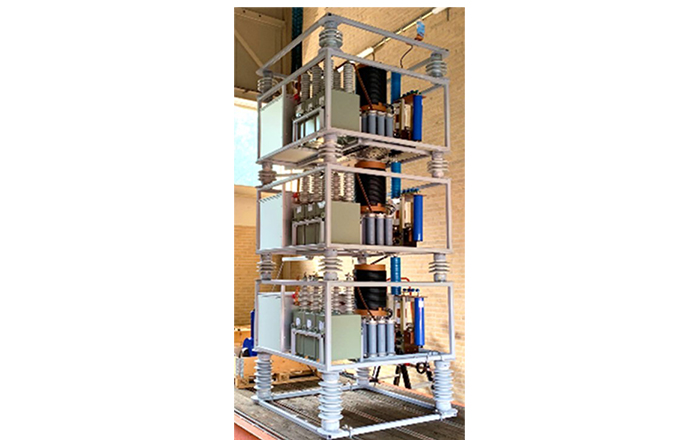 DC Circuit Breaker
DC Circuit Breaker
Related link
Contributing to the Optimal Use of Energy
BLEnDer® Series Software Package for the Electric Power Market
By making full use of ICT solutions, BLEnDer® aids in visualizing, managing, and trading electricity on an electric power network that is changing as solar, wind, and other renewable energy sources and storage batteries become more widespread. Mitsubishi Electric remains committed to supporting both stable power supplies and efficient operations by adapting to changes in the power market and energy trends.
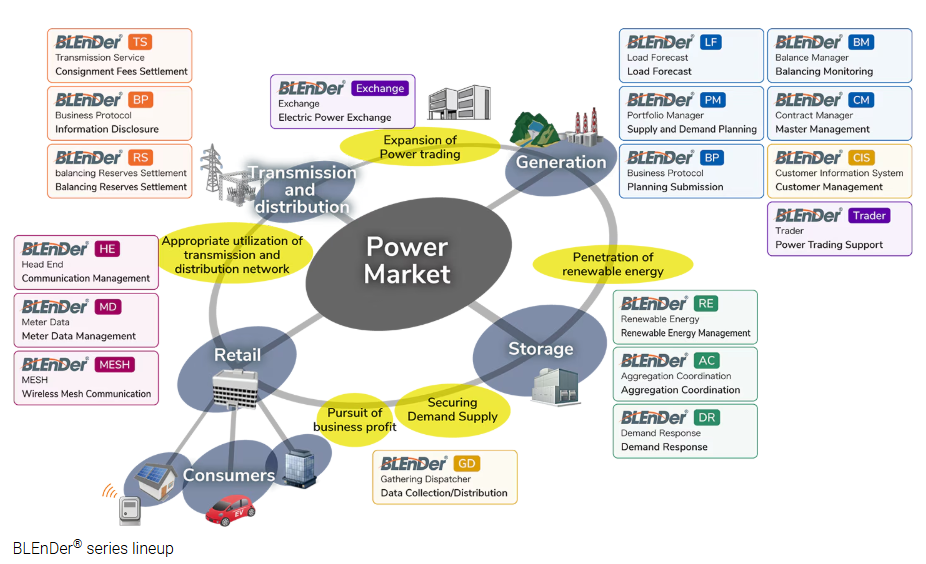
Related link
Contributing to World-Leading Global Environment Observation
Geostationary Meteorological Satellites Himawari-8/Himawari-9 and Greenhouse Gases Observing SATellite-2 IBUKI-2
The geostationary meteorological satellites Himawari-8 and Himawari-9 are the world’s first to be equipped with next-generation meteorological observational sensors. This enables them to improve the accuracy of weather forecasts and monitor various global environmental conditions such as sea surface temperature, phytoplankton concentration, sea ice, and volcanic smoke, as well as provide observational data to countries and regions in Asia and the Pacific, thereby contributing to the realization of more effective disaster prevention measures.
Furthermore, the Greenhouse Gases Observing SATellite-2 IBUKI-2 features high-performance onboard observational sensors, which increase accuracy in observing the concentration and distribution of greenhouse gases and contribute to observation of atmospheric pollution.
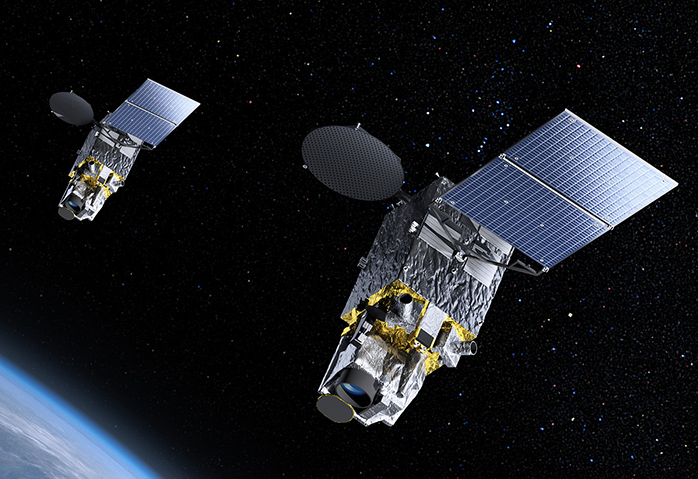 Geostationary Meteorological Satellites Himawari-8/Himawari-9
Geostationary Meteorological Satellites Himawari-8/Himawari-9
 ©JAXA Greenhouse Gases Observing SATellite-2 IBUKI-2 (GOSAT-2)
©JAXA Greenhouse Gases Observing SATellite-2 IBUKI-2 (GOSAT-2)
Related link
Contributing to Conserving the Global Environment and Ensuring Safe and Secure Living by Using Satellite Observation Data
Satellite Observation Solutions (Advanced Land Observing Satellite-4 DAICHI-4 [ALOS-4] and Advanced Land Observing Satellite-2 DAICHI-2 [ALOS-2])

©JAXA Advanced Land Observing Satellite-4 DAICHI-4 (ALOS-4)
Mitsubishi Electric possesses a series of technologies from planning satellite observation to processing and analyzing satellite images, which are fully utilized in providing optimal solutions for a customer’s business. The ALOS* series of land observing satellites developed and manufactured by Mitsubishi Electric are used as part of Japan’s national infrastructure for monitoring the situation during disasters, managing the nation’s land such as by updating maps, and for ocean and forest observation. Proof of technology related to infrastructure monitoring is also being implemented in partnership with national and local governments to contribute to disaster prevention and mitigation measures and to ensure safe and secure living.
- Advanced Land Observing Satellite
Related link
Contributing to Secure, Safe, and Comfortable Living through High Precision Positioning Solution
Quasi-Zenith Satellite System MICHIBIKI
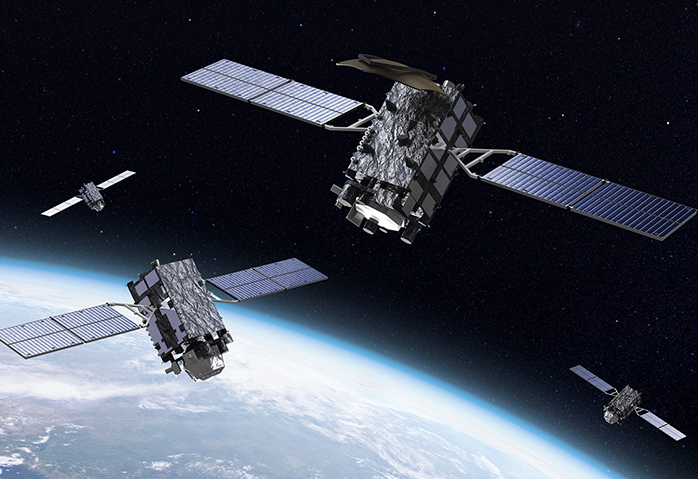
Quasi-Zenith Satellite System MICHIBIKI
In the Quasi-Zenith Satellite System MICHIBIKI, one satellite among the four positioning satellites is constantly positioned near the zenith above Japan. This allows positioning signals to be sent to spots where obtaining positioning information was previously difficult. By supplementing GPS signals, it also enables a positioning precision of up to the centimeter-level. By combining positioning data obtained from a high precision positioning terminal and other sources that receive positioning signals from satellites with this service and a high-accuracy 3D map generated from this positioning data, we will help make cities secure, safe, and comfortable for daily life, working in diverse fields including automobiles, railways, agriculture, construction, and civil engineering.
Related link
